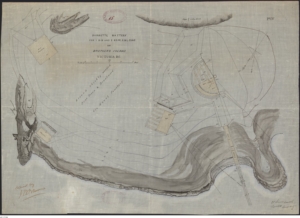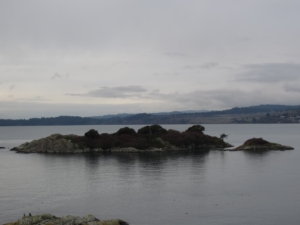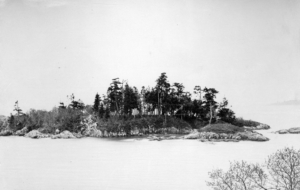Brother’s Island, just outside the entrance to Esquimalt Harbour and once called “Deadman’s Island” for obvious reasons, was the location of a cemetery for the Royal Navy at Esquimalt. Although the earliest reference to a burial on Brother’s Island was in 1850, the earliest known grave marker there was that of George Macaulay, the Chief Engineer of HMS Brisk, who died on August 2, 1855. The monument was inscribed “Erected by a friend who knew him long and valued him much.” There were 19 Royal Navy burials recorded on Deadman’s Island.
A second and preceding location was Fort Victoria’s graveyard at the corner of Douglas and Johnson streets, where Benjamin Topp RN, was buried in 1846. Also, three sailors from HMS Thetis were buried there in 1852. A third location for deceased Royal Navy officers and men was that of the Old Quadra Street Burying Ground, later and currently called Pioneer Square in Victoria where 55 burials are recorded. It housed the “Naval Corner” after 1856 and received the remains of burials transferred from the Fort Victoria graveyard commencing in 1859. Visit the “Old Cemeteries Society” for more on these two City of Victoria graveyards.
In 1868, a Royal Navy Cemetery with a chapel was created where it remains today, situated on the south side of the Gorge Vale Golf Course. Within the chapel of the now “Veteran’s Cemetery” are two large shield shaped plaques containing the names, rank and age of nineteen officers, seamen and marines and the ships they sailed on dating from 1850 to 1862, buried on “Deadman’s Island.” According to Admiralty correspondence in 1878, the intention was to relocate the buried remains of the nineteen souls to the new Royal Navy Cemetery to facilitate the installation of a three gun battery, a supporting magazine and artillery stores as required for the new coastal defence scheme. The work was to be done by private contract so “not to excite the susceptibilities of any persons interested in the grave yard at Deadman’s Island.” However, arrangements could not be finalized in time and two guns, an 8 inch and a 64 pounder both Rifled Muzzle Loaders, and a magazine, were installed in 1878 under the sense of defensive urgency of the day.
In 1886, the third gun, a second 64 pounder RML and an artillery store was initiated, along with the intended earlier prior relocation of the buried remains of the 19 Royal Navy Officers, Seamen and Marines. They were finally re-interred in 1887 in the new Royal Navy Cemetery as previously planned, with some expressed regret as to the timing. The cost of $660, paid for by the Admiralty, included: ”Viz. stone tablets and new head boards (if any) and new coffins in every case, and also the cost of digging the new graves.” The third gun, a 64 pounder RML, and artillery store were installed coincidentally with the relocation and reinternment procedure.
The completed armament of the battery on now “Brother’s Island” consisted of three guns, one 8 inch and two 64 pounder Rifled Muzzle Loaders, with a supporting magazine and artillery gun store. The guns had been strategically placed so that their seaward arcs of fire would protect Esquimalt harbour and from Rodd Hill to Macaulay Point against attack. They were hauled onto the island by virtue of a landing stage and stairway on the north – west shore of the island.
Three other earthen and wood batteries built and completed coincidentally in 1878 forming the initial Victoria- Esquimalt Coastal Defence Fortification’s network, were at Finlayson Point (two 64 pounder RML guns), Victoria Point (two 64 pounder RML guns) and the largest at Macaulay Point (three 7 inch RML guns). The four batteries were manned by the Victoria Battery of Garrison Artillery, the volunteer local militia unit at the time, until the arrival in 1887 of “C” Battery, Regiment of Canadian Artillery, in Victoria. Under the command of Lt. Col. J. G. Holmes, it was responsible for training the local militia while maintaining the armaments, stores and security of all four batteries. This responsibility included the Dominion of Canada powder magazine at Beacon Hill Park, a source of discontent within the City of Victoria, the Drill Shed / Hall in James Bay, and eventually the Clover Point rifle range along Dallas road waterfront.
On September 14th of 1888, a fire on Brother’s Island destroyed the three gun platforms, the wooden magazine and artillery gun stores. From all reports it appeared that the fire started from camp fires on the beach, “communicating with” the grass and brush which covered the island. A request was sent for replacement of the guns and stores to Ottawa including inventory from axes, to lanyards to shells. There was a minimum amount of powder stored on the island as the main quantity of the powder inventory was being stored in the magazine at Beacon Hill.
By this time in 1888, more modern and permanent breech loading gun emplacements were in the developing stages to enhance the Fort Macaulay battery and the building of a new battery at Fort Rodd Hill. It appears that the Brother’s Island battery was then soon abandoned rather than being rebuilt and remains today covered in brush, protected by “No Trespassing” signs.



 CFB Esquimalt Naval and Military Museum
CFB Esquimalt Naval and Military Museum CFB Esquimalt Naval and Military Museum
CFB Esquimalt Naval and Military Museum CFB Esquimalt Naval and Military Museum
CFB Esquimalt Naval and Military Museum CFB Esquimalt Naval and Military Museum
CFB Esquimalt Naval and Military Museum CFB Esquimalt Naval and Military Museum
CFB Esquimalt Naval and Military Museum CFB Esquimalt Naval and Military Museum
CFB Esquimalt Naval and Military Museum CFB Esquimalt Naval and Military Museum
CFB Esquimalt Naval and Military Museum CFB Esquimalt Naval and Military Museum
CFB Esquimalt Naval and Military Museum CFB Esquimalt Naval and Military Museum
CFB Esquimalt Naval and Military Museum CFB Esquimalt Naval and Military Museum
CFB Esquimalt Naval and Military Museum CFB Esquimalt Naval and Military Museum
CFB Esquimalt Naval and Military Museum CFB Esquimalt Naval and Military Museum
CFB Esquimalt Naval and Military Museum CFB Esquimalt Naval and Military Museum
CFB Esquimalt Naval and Military Museum CFB Esquimalt Naval and Military Museum
CFB Esquimalt Naval and Military Museum